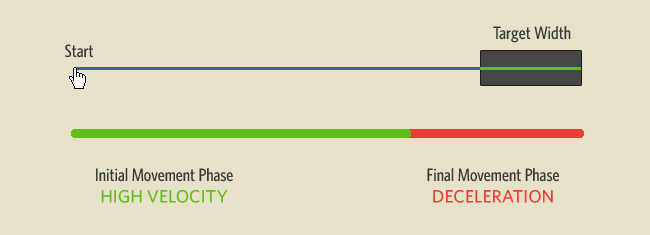Fitts's Law
Fitts's Law
"Fitts's law (often cited as Fitts' law) is a model of human movement primarily used in human–computer interaction and ergonomics that predicts that the time required to rapidly move to a target area is a function of the distance to the target and the size of the target. Fitts's law is used to model the act of pointing, either by physically touching an object with a hand or finger, or virtually, by pointing to an object on a computer monitor using a pointing device. It was proposed by Paul Fitts in 1954." [1]
Design and Usability
"the larger an item is, and the closer it is to your cursor, the easier it is to click on." [2]
Fitts's law - Wikipedia, the free encyclopedia - http://en.wikipedia.org/wiki/Fitts's_law
- "Fitts' law (often cited as Fitts's law) is a model of human movement primarily used in human–computer interaction and ergonomics that predicts that the time required to rapidly move to a target area is a function of the distance to the target and the size of the target. Fitts's law is used to model the act of pointing, either by physically touching an object with a hand or finger, or virtually, by pointing to an object on a computer monitor using a pointing device. It was proposed by Paul Fitts in 1954."
Crash corners and edges are one of the usability design tips promoted by "Fitt's Law".
Fitt's Law: "Edges and corners of the computer monitor (e.g., the location of the Start button in Microsoft Windows and the menus and Dock of Mac OS X) are particularly easy to acquire with a mouse, touchpad or trackball because the pointer remains at the screen edge regardless of how much further the mouse is moved, thus can be considered as having infinite width." [3]
Visualizing
Particletree » Visualizing Fitts’s Law - http://particletree.com/features/visualizing-fittss-law/
Articles
- Coding Horror: The Opposite of Fitts' Law - www.codinghorror.com/blog/2010/03/the-opposite-of-fitts-law.html
Visualizing Fitts’s Law
Mathematically, Fitts’s law is stated as follows:
MT = a + b log2(2A/W)
"Basically, that means that the time to acquire a target is a function of the distance to and size of the target. It seems like a no brainer. The farther you are and the smaller the target, the longer it takes to move the cursor and point at said target. " [4]
--
Fitts’s Law is Made of Lines

--
Rule of the Infinite Edge


--
hat should we do with UI elements we don't want users to click on? a half-dozen applications I regularly use where the ejector seat button is inexplicably placed right next to the cabin lights button.
Bad:

Good:

---
References:
- Particletree » Visualizing Fitts’s Law - http://www.particletree.com/features/visualizing-fittss-law/
- Coding Horror: The Opposite of Fitts' Law - http://www.codinghorror.com/blog/2010/03/the-opposite-of-fitts-law.html
Hick's Law
See also Hick's Law
Hick's law - Wikipedia - http://en.wikipedia.org/wiki/Hick%27s_law
"Hick's Law, named after British psychologist William Edmund Hick, or the Hick–Hyman Law (for Ray Hyman), describes the time it takes for a person to make a decision as a result of the possible choices he or she has. The Hick-Hyman Law assesses cognitive information capacity in choice reaction experiments. The amount of time taken to process a certain amount of bits in the Hick-Hyman Law is known as the rate of gain of information.
Hick's Law is similar in form to Fitts's law. Intuitively, one can reason that Hick's Law has a logarithmic form because people subdivide the total collection of choices into categories, eliminating about half of the remaining choices at each step, rather than considering each and every choice one-by-one, requiring linear time."
notes
"According to Fitt's Law, corners and edges have infinite width as far as the user is concerned, one of the reasons I have loved GNOME for so long now is because of the use of corners, so imagine my surprise when I can no longer simply throw my mouse cursor up into the corner and simply CLOSE the maximized window that I'm currently using, instead it drags the window. This is obnoxious and useless. I can already grab at any other part of the top edge of the screen outside of the far corner in order to drag a window, why is this happening again? It is SO frustrating particularly since GNOME is supposed to be so damned concerned with usability." [5]
See Also
keywords
crash corners crash edges